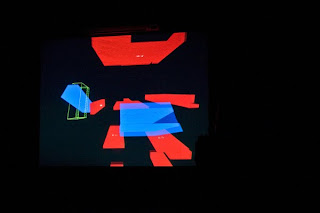
Txt: Wu, Ting-Hsien, Photo: CAI Xin-Yi, Records: CHANG Yung-Ta, Translate: Brenda Chan
文字:吳庭嫻, 攝影:蔡欣邑, 錄音:張永達
轉貼自http://lsf.iolab.tw/2010/10/listen-40-%e2%80%93-audio-and-photo/
影片連結http://lsf.iolab.tw/2010/10/listen-40-excerpt-video/
Zhang You-Sheng stood on the stage, the desk in front of him was full of his stuff, it was like the priest was about to start up a ceremony. The cymbal with a hole in the middle and let a twisted steel wire rub against it, and make sharp and intolerant noises. The performer had already been lost in abstraction, the sounds of processed no-input was quite bloody, they seemed to be throwing meats to the audiences and kept challenging the limit of everyone.
The creator is the planner of a small-size music festival -“NOISE80000V”. He is heavily obsessed with noise. He referred that no-input is “the entrance is the exit for sounds”(ex. The circulative logic like the sound enters to the microphone and the sound out of the speaker). And input is like the vibration after playing guitar strings, it will pass by the conducting wire and then the amp produces sound—— “the entrance is not the exit for sounds”, these are linear relation but not circulative relation. The world of sound is generally concluded by these two logics. The performance today I used contact microphone to enlarge the sounds, the whole performance share the ratio of 50% input and 50% no-input.
The creator referred that even the sound of no-input is more dangerous and hard to control. He still could do the various changes of tone and frequency from the mess structures. In the performance, he alternated the national song of Russia, international song, Mac Gyver, Farewell My Concubine, Hsueh Yueh“If There Is Still a Tomorrow”, and his humming tune. Through these different sequences of ideas, Zhang You-Sheng wanted to make audiences feel some kind of stupid, mess, violent and hateful situation to drain his question towards sounds.
張又升站在舞台上,前方桌子堆滿了他的物件,像是祭司正要展開一場儀式。中間被挖了洞的鈸,讓一根扭曲的鐵絲不斷抽送,發出尖銳的、令人難受的噪音。表演者已進入出神狀態,被處理過的no-input聲音相當血腥,好似擲向觀者的肉塊,不斷挑戰大家的忍耐極限。
創作者是即興噪音小型音樂祭 “噪音八萬伏特” (NOISE80000V) 的策劃人,對於噪音的癡迷到了重鹹的程度。他表示,no-input就是「聲音入口處即聲音出口處」 (ex: 從麥克風進入的聲音與從喇叭傳出的聲音相互循環的邏輯),而input就像是吉他撥弦震動後,先經導線而後由音箱發出的聲音──「聲音入口處非聲音出口處」,兩者是線性關係,而非循環關係。整個聲音世界大體上就是這兩種邏輯。今天的表演是以觸控式麥克風 (contact mic) 將聲音放大,整段表演有一半input,一半no-input。
創作者表示,即使no-input聲音比較危險、不好操縱,但還是能在亂中有序的結構裡,追求噪音在音色和頻率上的豐富變化。表演中,穿插了蘇聯國歌、國際歌、百戰天龍、霸王別姬的段子、薛岳的「如果還有明天」和創作者的自哼歌曲。藉由這些不同的脈絡,張又升想讓觀者感受到一種癡愚、髒亂、暴力又討人厭的狀態,藉此宣洩他對聲音的提問。
Lsf 40 - Chang, Yo-Sheng (張又升) by iolab.tw





